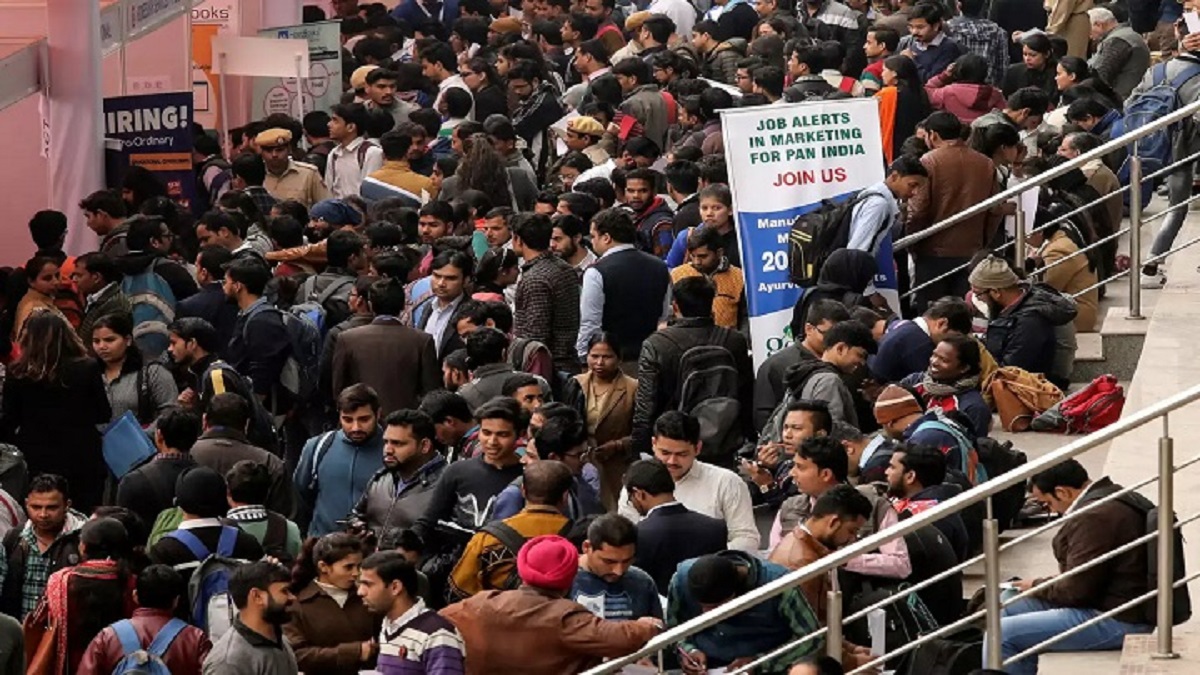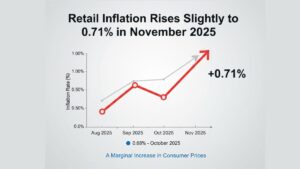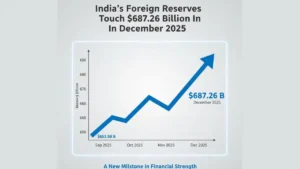The urban unemployment rate in India stood unchanged at 6.4% in the October-December quarter of FY25, according to the latest Periodic Labour Force Survey (PLFS) released by the Ministry of Statistics and Programme Implementation (MoSPI) on February 18, 2025. This follows a slight decline from 6.6% in Q1 FY25 to 6.4% in Q2 FY25, indicating a stable employment scenario in urban areas.
Despite the steady overall unemployment rate, the survey reveals shifts in gender-specific job trends, youth employment levels, and labor force participation. The data provides insights into urban labor market conditions and is critical for policymakers assessing employment patterns.
How Has Urban Unemployment Changed Across Gender?
- Male Unemployment: The unemployment rate among men in urban areas increased slightly to 5.8% in Q3 FY25, up from 5.7% in the previous quarter.
- Female Unemployment: The unemployment rate among women improved, dropping to 8.1% in Q3 FY25 from 8.4% in Q2 FY25, suggesting improved job opportunities for women in urban areas.
The improvement in female employment aligns with efforts to enhance workforce participation, but the gap between male and female employment remains significant.
What Are the Trends in Youth Employment?
Youth unemployment, a critical indicator for economic growth, saw a minor increase:
- Ages 15-29: The unemployment rate for young individuals in this group rose to 16.1% in Q3 FY25 from 15.8% in Q2 FY25.
- The trend signals challenges in job availability for fresh graduates and first-time job seekers.
This slight increase reflects the difficulty in absorbing young professionals into the labor market despite overall employment stability.
How Has the Labour Force Participation Rate (LFPR) Evolved?
The Labour Force Participation Rate (LFPR) in urban areas remained stable at 50.4% in Q3 FY25, but there were slight changes within gender groups:
- Male LFPR: Increased to 75.4% from 75% in Q2 FY25, suggesting more men engaging in economic activities.
- Female LFPR: Declined slightly to 25.2% from 25.5%, indicating a marginal withdrawal of women from the workforce.
While men’s participation improved, the dip in female LFPR highlights the need for policies encouraging women’s sustained employment.
What Is the Employment Distribution Across Sectors?
The survey also analyzed employment types and sector-wise job shares:
- Self-Employment: 39.9% of the urban workforce remains self-employed.
- Regular/Salaried Employment: 49.4% of workers hold regular salaried jobs.
- Casual Labour: 10.7% of the workforce relies on daily wage employment.
A key positive trend was an increase in female regular employment, which rose to 54.8% in Q3 FY25 from 53.8% in Q2 FY25. However, male regular employment saw a slight decline from 47.9% to 47.7%.
In terms of sectoral employment distribution
- Tertiary (Services) Sector: Employment share increased to 62.7% in Q3 FY25 from 62.3% in Q2 FY25, reflecting growth in service-oriented industries.
- Secondary (Manufacturing) Sector: Employment share dropped slightly from 32.3% to 31.8%, signaling a minor contraction in industrial jobs.
Why Is This Data Important?
The PLFS, launched in April 2017, provides quarterly updates on employment conditions in urban India. The latest report, the 25th in this series, offers crucial insights for policymakers, economists, and businesses. The urban job market has shown stability, but challenges remain, especially in youth employment and female workforce participation.
For a sustained improvement, experts suggest sectoral diversification, job creation strategies, and policies encouraging female employment. The government’s focus on skill development and industrial expansion will be key to ensuring long-term urban employment growth.
Urban Unemployment Rate in Q3 FY25: Key Highlights
| Key Aspect | Details |
|---|---|
| Why in News? | Urban unemployment rate remained steady at 6.4% in Q3 FY25 (Oct-Dec), as per PLFS data by MoSPI. |
| Male Unemployment | Increased slightly to 5.8% from 5.7% in Q2 FY25. |
| Female Unemployment | Improved to 8.1% from 8.4% in Q2 FY25. |
| Youth Unemployment (15-29 years) | Increased to 16.1% from 15.8%, signaling job market challenges for young professionals. |
| Labour Force Participation Rate (LFPR) | Unchanged at 50.4% overall. |
| Male LFPR | Increased to 75.4% from 75%. |
| Female LFPR | Decreased slightly to 25.2% from 25.5%. |
| Employment Type Distribution | Self-Employed: 39.9%, Regular/Salaried: 49.4%, Casual Labour: 10.7%. |
| Women in Regular Jobs | Increased to 54.8% from 53.8% in Q2 FY25. |
| Manufacturing Jobs (Secondary Sector) | Declined to 31.8% from 32.3%. |
| Services Sector Jobs (Tertiary Sector) | Increased to 62.7% from 62.3%, showing growth. |
| Report Release Date | February 18, 2025. |
| Data Source | Periodic Labour Force Survey (PLFS), Ministry of Statistics and Programme Implementation (MoSPI). |



 Retail Inflation Rises Slightly to 0.71%...
Retail Inflation Rises Slightly to 0.71%...
 India’s Foreign Reserves Touch $687.26 B...
India’s Foreign Reserves Touch $687.26 B...
 ADB Raises India’s Growth Forecast to 7....
ADB Raises India’s Growth Forecast to 7....







